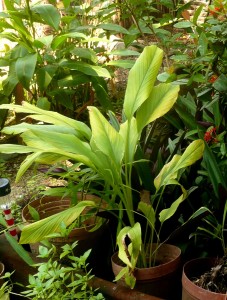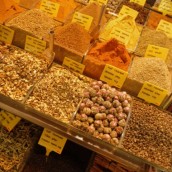About turmeric, and a quick turmeric golden milk recipe
The healing and anti-inflammatory properties of turmeric have been making a big, orange splash on the Internet and in the press recently. Turmeric is that bright-orange spice that forms one of the basic ingredients of curry and gives it a deep earthy tone. Turmeric has been used, along with other spices, herbs, and roots, to produce dye for the traditional saffron robes of Buddhist monks. Other natural colors were produced by using leaves, roots, fruits, bark, and flowers of a variety of plants and trees.
Below are a reference articles citing studies in which turmeric (or curcumin, as its most active medicinal component is called) has shown great promise for inflammation, diabetes, to bolster vascular health, and many other possible applications. The latest article from Higher Perspective, The Spice That Prevents Fluoride From Destroying Your Brain, cites a study that indicates curcumin is effective against fluoride neurotoxicity and can protect the brain from its effects.
Science Confirms Turmeric As Effective As 14 Drugs from GreenMedInfo: An article comparing turmeric or curcumin favorably to a series of conventional medications.
Top 10 Evidence-Based Health Benefits of Turmeric and Curcumin from Authority Nutrition: An evidence-based approach
Health Benefits of Black Pepper and Turmeric from Turmeric for Health. This article will explain to you why a combination of black pepper and turmeric is so often recommended.

Turmeric plant (center, with long, light-green leaves)
Turmeric Golden Milk Paste
One of my favorite ways to use turmeric, other than in culinary curries, is to make a paste of the dried turmeric powder with powdered cinnamon, pepper, and water.
I keep the paste in the fridge and add it to warmed almond milk, sweeten it with a spoonful of honey, and add the crowning touch that sets off its flavor perfectly: a few drops to a teaspoonful of organic coconut oil.
Turmeric milk has become a comfort food for me; it’s a relaxer at the end of the day and, with the addition of cinnamon and coconut oil, it satisfies my taste buds. I find it an easy way to incorporate more turmeric into my daily diet without the accompanying strong flavor of the rest of the curry spices.
To prepare the turmeric paste, simmer about 1/4 cup of turmeric powder in 1/2 cup of water, stirring constantly with a small wooden spatula and adding more water as necessary as the mixture thickens. Do not allow it to stick and burn. A slightly runny paste is easiest to use. Simmer for at least 7 minutes. Add a grating of fresh ground black pepper (1/8 to 1/4 tsp) and a tablespoon of cinnamon powder. Add more water if necessary, and simmer for another minute or two. Remove from heat and let cool.

Spices
Store the paste in the fridge in a closed container. Whenever you feel the urge, heat up a cupful of almond milk (sometimes I use 1/2 almond milk and 1/2 water), add a spoonful (to taste) of turmeric paste, and sweeten to taste with honey. Finally, stir in several drops (or up to a teaspoonful) of good quality, organic coconut oil. The oil will tend to float, but just give it a stir before every sip. The coconut oil imparts to the turmeric/almond milk a heavenly and soothing taste and richness.
Other sources:
“The Monastic Robes,” Buddhanet website, http://www.buddhanet.net/e-learning/buddhistworld/robe_txt.htm
“Turmeric – Kamin,” Thai Food and Travel website, http://www.thaifoodandtravel.com/ingredients/turmeric.html
Helen Gordon Young, “Saffron Robes and Real People Like Me,” Heather Gordon Young website, http://www.heathergordon-young.com/saffron-robes-and-real-people-like-me/